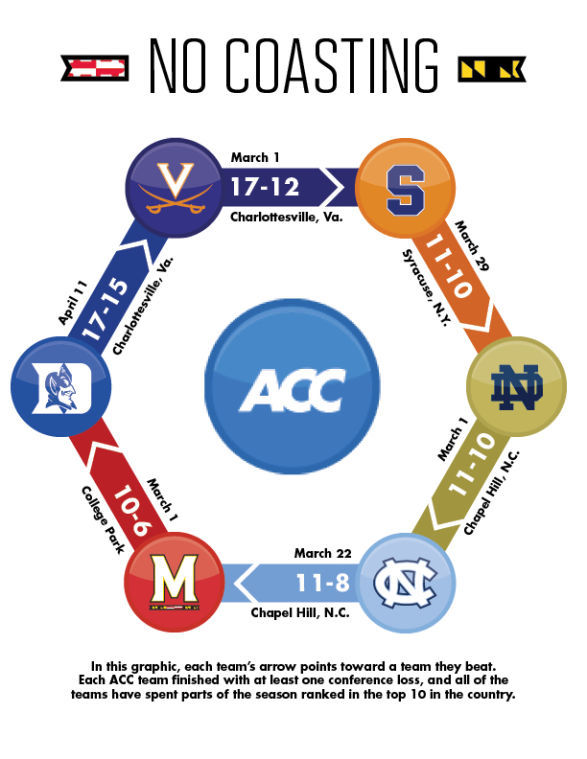After the final whistle blows at the conclusion of the ACC men’s lacrosse championship game Sunday afternoon in Chester, Pa., the conference’s unique 2014 season will exist only as a memory.
The top-seeded Terrapins men’s lacrosse team, which faces No. 4-seed Notre Dame in the semifinals tonight at PPL Park, will depart for the Big Ten next season, leaving the ACC with five men’s teams.
This season, though, the ACC has presented an array of exceptional teams and players that some experts say has never existed in any conference in the history of Division I lacrosse. Entering the conference tournament, all six teams rank in the top 15 in the country. Five of the six teams have top-10 scoring offenses, and all averaged more than 11.5 goals per game during the regular season.
Even with the Terps’ withdrawal, the ACC will have the capability to thrive as a premiere Division I lacrosse conference in 2015 and beyond because of the addition of Syracuse and Notre Dame in 2013. But the 2014 season — the only season the Terps, Orange and Fighting Irish all played in the same league — will remain fixed in the sport’s history for its competition and parity.
“It’s the best lacrosse conference ever assembled,” said midfielder Joe LoCascio, a product of St. Anthony’s High School on Long Island. “As a kid, you grow up watching these teams play, and now, when you’re a part of it, it truly is special.”
ON TO CHESTER
For the first time since the ACC tournament began in 1989, an automatic qualifying bid will accompany the conference title.
Newcomers Syracuse and Notre Dame brought the ACC’s member total to six teams for 2014, meaning the conference champion will get one of 10 automatic bids to the NCAA tournament. Next year, the ACC will maintain control of its automatic bid despite the Terps’ exit thanks to a one-year exemption from the NCAA.
During the first 25 years of the tournament, the four conference members — the Terps, Virginia, Duke and North Carolina — were guaranteed a spot in a semifinal game. This year, though, six teams vied for four spots. And eventually, the Cavaliers and Tar Heels were left out of the tournament field.
“Knowing that you weren’t necessarily going to get invited to be in the tournament made those [conference] games that much more important,” coach John Tillman said.
The No. 2-seed Blue Devils and No. 3-seed Orange will match up in the opening semifinal game tonight at 5 p.m. The Terps battle the Fighting Irish for the second time in seven days in the other semifinal at 7:30 p.m.
The Tar Heels and Cavaliers will face off in the ACC Showcase game Saturday night as a treat for the fans. The game is just an exhibition, though, and will have no bearing on the outcome of the tournament.
The weekend will culminate in the championship game Sunday at 1 p.m.
“I’ve covered the ACC tournament many years and I’ve always, quite honestly, thought it should be called the ACC redundancy tournament,” said ESPN lacrosse analyst Quint Kessenich, who was an All-America goalkeeper at Johns Hopkins from 1987 to 1990. “It was meaningless. The players would dance around the field with a gold trophy afterwards, but it didn’t come with an automatic qualifier. … Now, with the automatic qualifier, I think it actually is a worthwhile endeavor.”
FULL CIRCLE
During the 2014 regular season, the six ACC men’s lacrosse teams displayed the ruthless and unpredictable nature of the nation’s elite conference nearly every weekend.
The Terps crushed then-No. 1 Syracuse by eight goals at the Carrier Dome on Feb. 22 but lost to then-No. 6 North Carolina in Chapel Hill a month later. The Orange defeated the Tar Heels at home by one goal on April 12 but lost to Virginia by five goals on March 1 in Charlottesville, Va. — the Cavaliers’ lone conference win of the season. Meanwhile, the Tar Heels defeated Virginia at home on April 5.
In total, all three of Syracuse’s losses came to ACC opponents. All three of North Carolina’s losses came to ACC opponents. Four of the Cavaliers’ five losses came to ACC opponents. And three of the Fighting Irish’s five losses came at the hands of a conference foe.
(Click to enlarge)

ACC Tournament graphic
“I think that’s part of the uniqueness,” Tillman said. “You’ve got to come with your ‘A’ game, or you’re not coming home with a ‘W.’ You can’t take a quarter off. You can’t relax.”
Tillman said the most difficult aspect of this season was preparing for the extra two conference games against the Orange and Notre Dame. Before this year, the fourth-year coach would have to prepare for only four ACC weekends: three regular-season games and the conference tournament. This season, the Terps were forced to cope with six weeks of ACC competition — a grueling task when injuries and streaky play are factored into the equation.
“The margin is so small between winning and losing,” Tillman said.
RAMPANT REALIGNMENT
The landscape of Division I college lacrosse is changing. And it’s changing quickly.
The NCAA recognized 10 conferences this season for automatic qualifying bids — the most ever. They are the America East, ACC, Atlantic Sun, Big East, Colonial, Eastern, Ivy League, Metro Atlantic, Northeast and Patriot League. Next season, that number will grow even larger, as the Terps and Johns Hopkins join Ohio State, Penn State, Michigan and Rutgers to form Big Ten men’s lacrosse.
However, Kessenich said there are both positives and negatives to this situation. Yes, the ultimate goal is to grow the sport, and a larger national tournament field is a good measurement of that growth. Yet there are some things the former All-American can’t wrap his head around.
“Why is Denver in the Big East?” Kessenich said. “That’s insane.”
Kessenich believes realignment will continue for the foreseeable future. Major-conference teams jumping to different leagues without much thought for traditional rivalries or geographic location forces mid-major conference teams, such as Denver, to find homes or risk being left behind.
Another issue Kessenich sees with realignment is pertinent to the ACC this season. There is a chance a pair of ACC teams will meet three times during their potential national-championship runs: once during the regular season, once in the conference tournament and once in the NCAA tournament. With 67 Division I teams, Kessenich doesn’t think those excess matchups are necessary.
“When I was an athlete, I wanted to play new faces, new schools,” Kessenich said.
After this season, though, realignment will bring a swift and anticlimactic end to the 2014 ACC, which Kessenich said includes the best six teams to ever exist in a conference together.
Tillman and the Terps are excited about their opportunity to play in the Big Ten. But after this weekend, they’ll be leaving behind a conference that will continue to feature battles between some of lacrosse’s most consistently successful programs.
“This is a one-and-done deal,” Kessenich said. “Everyone knew that this was an epic year in the conference.”






